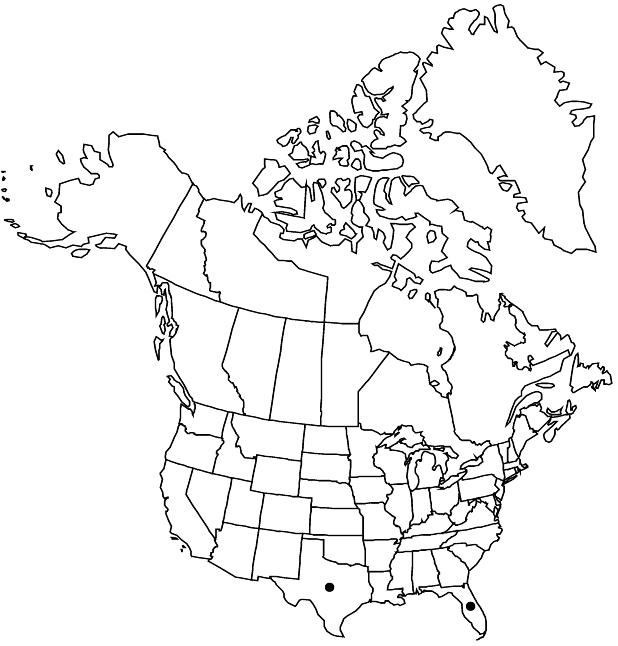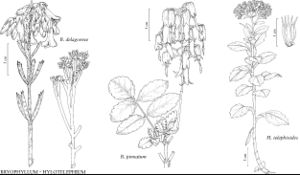Difference between revisions of "Bryophyllum delagoense"
Mém. Herb. Boissier 10: 38. 1900 ,.
FNA>Volume Importer |
imported>Volume Importer |
||
| (3 intermediate revisions by 2 users not shown) | |||
| Line 10: | Line 10: | ||
|name=Kalanchoë delagoensis | |name=Kalanchoë delagoensis | ||
|authority=Ecklon & Zeyher | |authority=Ecklon & Zeyher | ||
| + | |rank=species | ||
|publication_title=Enum. Pl. Afric. Austral., | |publication_title=Enum. Pl. Afric. Austral., | ||
|publication_place=305. 1837 | |publication_place=305. 1837 | ||
| Line 16: | Line 17: | ||
|name=Kalanchoë verticillata | |name=Kalanchoë verticillata | ||
|authority=Scott-Elliot | |authority=Scott-Elliot | ||
| + | |rank=species | ||
}} | }} | ||
|hierarchy=Crassulaceae;Bryophyllum;Bryophyllum delagoense | |hierarchy=Crassulaceae;Bryophyllum;Bryophyllum delagoense | ||
| Line 31: | Line 33: | ||
|elevation=0 m | |elevation=0 m | ||
|distribution=Fla.;Tex.;Indian Ocean Islands (Madagascar);introduced also in s Africa;Pacific Islands (at least Hawaii);Australia. | |distribution=Fla.;Tex.;Indian Ocean Islands (Madagascar);introduced also in s Africa;Pacific Islands (at least Hawaii);Australia. | ||
| + | |introduced=true | ||
|discussion=<p>The names <i>Bryophyllum</i> tubiflorum and <i>Kalanchoë</i> tubiflora are widely used in horticultural as well as botanical works, with K. delagoensis usually listed in synonymy as a nomen nudum. H. R. Toelken (1985) wrote that the three-word original diagnosis of K. delagoensis was enough to distinguish it from other species treated. R. W. Long and O. Lakela (1971) misidentified it as <i>K. grandiflora</i> A. Richards.</p><!-- | |discussion=<p>The names <i>Bryophyllum</i> tubiflorum and <i>Kalanchoë</i> tubiflora are widely used in horticultural as well as botanical works, with K. delagoensis usually listed in synonymy as a nomen nudum. H. R. Toelken (1985) wrote that the three-word original diagnosis of K. delagoensis was enough to distinguish it from other species treated. R. W. Long and O. Lakela (1971) misidentified it as <i>K. grandiflora</i> A. Richards.</p><!-- | ||
--><p>The subcylindric part of the leaf seems to be the petiole, bearing a greatly reduced blade with one to four pairs of teeth (P. Boiteau and L. Allorge-Boiteau 1995).</p><!-- | --><p>The subcylindric part of the leaf seems to be the petiole, bearing a greatly reduced blade with one to four pairs of teeth (P. Boiteau and L. Allorge-Boiteau 1995).</p><!-- | ||
| Line 45: | Line 48: | ||
-->{{#Taxon: | -->{{#Taxon: | ||
name=Bryophyllum delagoense | name=Bryophyllum delagoense | ||
| − | |||
|authority=(Ecklon & Zeyher) Schinz | |authority=(Ecklon & Zeyher) Schinz | ||
|rank=species | |rank=species | ||
| Line 61: | Line 63: | ||
|publication year= | |publication year= | ||
|special status= | |special status= | ||
| − | |source xml=https:// | + | |source xml=https://bitbucket.org/aafc-mbb/fna-data-curation/src/2e0870ddd59836b60bcf96646a41e87ea5a5943a/coarse_grained_fna_xml/V8/V8_322.xml |
|genus=Bryophyllum | |genus=Bryophyllum | ||
|species=Bryophyllum delagoense | |species=Bryophyllum delagoense | ||
Latest revision as of 22:42, 5 November 2020
Herbs, monocarpic, (sometimes suckering at base), pale green mottled with violet-brown, glaucous. Stems simple, terete, 5–20 dm × 0.5–1 cm. Leaves mostly in 3s, opposite or whorled, evenly spaced, simple; petiole and blade indistinguishable, reddish green to gray-green with reddish brown spots, narrowly oblong, subcylindric, grooved adaxially, 3–15 cm × 3–6 mm, margins entire except for 3–9 conic teeth at apex, apex blunt, surfaces not glaucous; bulbils borne between teeth, spurs spoon-shaped. Cymes mostly dense, corymbiform, 0.5–2 dm diam.; branches to 3 cm. Pedicels 5–30 mm. Flowers: calyx pale green, not inflated, 8–16 mm, tube 3–6 mm, lobes triangular, 5–10 mm, longer than tube, apex acuminate; corolla orange to scarlet, 25–40 mm, not contracted basally, lobes obovate, 6–12 mm, apex rounded or apiculate. 2n = 68.
Phenology: Flowering winter, spring.
Habitat: Cactus-mesquite thickets, shell mounds, waste places
Elevation: 0 m
Distribution

Introduced; Fla., Tex., Indian Ocean Islands (Madagascar), introduced also in s Africa, Pacific Islands (at least Hawaii), Australia.
Discussion
The names Bryophyllum tubiflorum and Kalanchoë tubiflora are widely used in horticultural as well as botanical works, with K. delagoensis usually listed in synonymy as a nomen nudum. H. R. Toelken (1985) wrote that the three-word original diagnosis of K. delagoensis was enough to distinguish it from other species treated. R. W. Long and O. Lakela (1971) misidentified it as K. grandiflora A. Richards.
The subcylindric part of the leaf seems to be the petiole, bearing a greatly reduced blade with one to four pairs of teeth (P. Boiteau and L. Allorge-Boiteau 1995).
This prolific species is an aggressive weed, well established in southern Florida and coastal southern Texas. In Australia, where it is called “mother of millions,” it is a serious pest because it is highly poisonous to cattle (P. I. Forster 1996).
